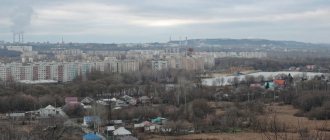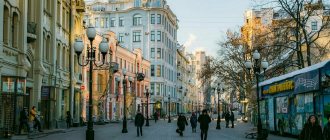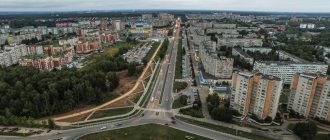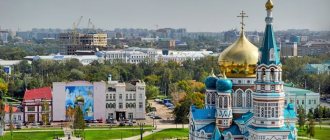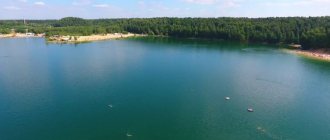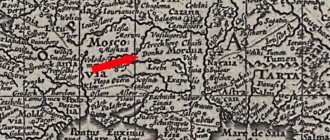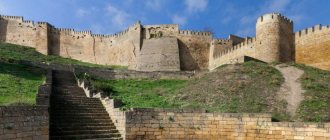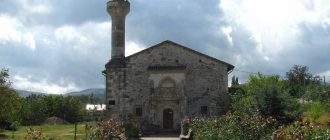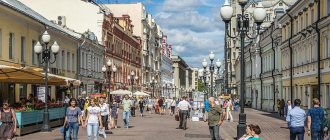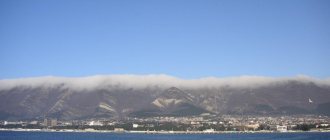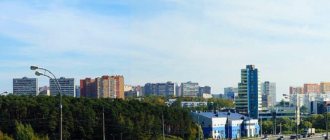- October 4, 2019
- Directions
- Molton
Stary Oskol is one of the cities in the European territory of Russia. Not everyone knows where Stary Oskol is located. This city is located on the banks of the Oskol River and its tributaries, at a distance of 153 km northeast of Belgorod. The border with the Kursk region passes nearby. The nearest city is Gubkin.
The number of residents of the city of Stary Oskol is 223,360 people, which puts it in second place in the region. Stary Oskol is a cultural and administrative center of regional significance. Many people ask the question in which region Stary Oskol is located and where it is. According to Wikipedia, the city is located in the Belgorod region. It is south and partly west of Moscow.
Stary Oskol was founded in 1596. At the moment it has an area of 201 km2. The approximate height above sea level is 150 meters.
Ecology and infrastructure
The environmental situation in the city as a whole is relatively favorable. Despite the operation of a significant number of enterprises, exceeding the maximum permissible standards is not observed. However, this does not mean that everything is perfect with the environment in the city. There really are no toxic industries here, but there are many industrial facilities that, of course, do not contribute to crystal clear air. Urban transport obviously also makes its contribution.
Stary Oskol is considered one of the most comfortable in the country. There are also many modern, neat high-rise buildings, and new high-rise buildings are being built. The housing and communal services situation here is better than in the country as a whole.
There are a lot of sports facilities in Stary Oskol.
Stary Oskol
Stary Oskol can offer tourists visiting it attractions for every taste - historical monuments, ancient buildings, natural sites.
Historic houses
A special feature of the city is that it still has suburban areas, the presence of which creates a unique atmosphere of antiquity. Guests of Stary Oskol, first of all, pay attention to merchant houses built in the 19th - 20th centuries.
Among the interesting local buildings in the center are the buildings of a real school and a former women's gymnasium, shopping arcades, a noble assembly, the house of merchants - Fedyushin, Diaghilev, Likhushin and other famous personalities.
House of the merchant Theodorin
© Sonic_off
So, on Lenin Street, for example, there is a mansion of the merchant Solomentsev , built at the beginning of the 20th century. The Solomentsev family is known for the fact that 15 people from it became monks. Among them is Hieromonk Jerome, abbot of the Russian St. Panteleimon Monastery on Holy Mount Athos in Greece. Initially, the house of the merchant Solomentsev was two-story, with two balconies. Since 1934, the Stary Oskol Geological Exploration College was located here, and during the war years - a military hospital. Now it houses a branch of the Russian State Geological Prospecting University. S. Ordzhonikidze.
Notable is the building of Dyakov's office in the Art Nouveau style, located on the territory of the former Dyakov oil mill (now the Slavyanka confectionery factory). The house was built at the turn of the 19th - 20th centuries; it housed the office services of the former factory, however, even now the building performs the same functions - the administration of the factory is located in it.
An interesting building in which the city Public Bank belonged to the merchant Feodorin, built at the end of the 19th century. It was the first bank opened in Stary Oskol in 1868. The fixed capital at the opening in 1868 was 10,000 rubles, and in less than 30 years, by 1894, it had grown sevenfold. The bank was actively involved in charity work and over a quarter of a century issued about 8,000 rubles for the construction of buildings and educational institutions. An L-shaped structure with two floors from the end of the 19th century. combines eclectic and modern styles and is located at the intersection of Lenin and Komsomolskaya streets.
House of merchant Fedyushin
© Sonic_off
Unfortunately, only ruins remain of the house of the merchant Kobzev Local residents called this mansion “Margarita’s Caprice.” The wooden house was built in 1891 by order of a merchant for his daughter Margarita in record time - in just 32 days. After the revolution, various institutions were located here, and in the 1990s. it was almost completely dismantled and soon collapsed.
Turminsky Pharmacy is another historical building in Stary Oskol, located on Lenin Street. The L-shaped structure is distinguished by rich relief decoration; it was opened in 1912 by Pyotr Aleksandrovich Turminsky, a pharmacist from Voronezh. The pharmacy was used for its intended purpose before the revolution. Then various organizations were located here - the editorial office of the Izvestia newspaper, a kindergarten, and the financial department. It was even a residential building.
The building of the former City School (1870) is located on Volodarsky Street. It is distinguished by floors of different heights and two types of windows - arched and beamed. The building is one of the oldest in the city; it was built with money from patrons, in particular the merchant Ivan Petrovich Makarov. A scholarship for students was also established with his funds. The institution taught carpentry, carpentry, blacksmithing, and plumbing. After the revolution there was a school here, and during the war there was a commandant’s office. Now the Center for Technical and Youth Creativity is located here.
Shopping arcades
© Sonic_off
Next to the Ascension Church on Mira Street, a small two-story brick building is the former Cossack parish school , built in 1892. Educational institutions were located in this building until the early 1990s. At the moment, the building is empty and has a mystical fame among local residents - at night people see lights in the windows.
a house of the merchant Fedyushin in the city - residential, it is considered an architectural monument. At various times, the building housed the registration chamber, a private women's gymnasium, and during the war - the Stary Oskol district party committee, the State Defense Committee, the headquarters of the partisan movement of the Kursk region, and the Kursk regional party committee.
In addition, the city is distinguished by the Administration buildings on Lenin and Komsomolskaya streets, as well as the grandiose Palace of Celebrations .
Monuments
The ensemble of the historical center also includes many monuments.
Monument to Zhukov
© Igor Butyrskii
Among them, for example, are monuments to the merchant Simonov , the founding fathers of the city - Ivan Myasny, Ivan Solntsev-Zasekin and Mikhail Nechaev, located on Oktyabrskaya Square. The monument to N.F. Vatutin is located at the entrance to the Vatutin stadium, and to V.I. Ulyanov-Lenin - on Lenin Street of the same name. In addition, in the center you can find a monument to internationalist soldiers (at the intersection of 9 January and Proletarskaya streets), a memorial sign in honor of the fallen sailors of the Russian Navy and the “First Ore” monument. In Stary Oskol, the feat of Soviet soldiers during the Great Patriotic War is honored: in 1942-1943. The most fierce battles took place precisely on the territory of the Stary Oskol region.
In memory of the tragic events of that war and those killed in battles in the second half of the last century, many monuments and memorials were erected in the city. Among them are the memorial complex “Ataman Forest”, a monument to Marshal Zhukov on Victory Square - the first in the USSR, a memorial in honor of fallen railway workers and others.
Stele "City of Military Glory"
© Sonic_off
Some monuments of Stary Oskol appeared already in the 19th century: for example, the stele “City of Military Glory” and the sculptural complex “June 22, 1941” , installed in 2011. The Walk of Fame of Stary Oskol - Heroes of the Soviet Union appeared in 2008-2009, and the sculptural composition “After the Battle” - in 2012. There is also a monument to the deputies of the Cossack village council who were shot during the Nazi occupation; it is located on Mira Street.
The city has a Military Glory Park, located between Lenin and Proletarskaya streets. This park is the oldest in Stary Oskol, it is small, quiet and cozy, with squares, flower beds, benches and walking paths. It has a number of monuments - St. Alexander Nevsky (built in 2010), Chernobyl victims (1996), border guards (2005) and the "Grieving Mother" memorial , installed in 1985 in memory of the execution of civilians by fascist invaders .
Museums
The city boasts a number of interesting museums.
So, not far from the Park of Military Glory there is the Museum of Local Lore - the oldest museum institution in the Belgorod region - with a good collection of exhibits telling about the history, nature, industry, and life of the inhabitants of Stary Oskol in different periods. In the museum’s collection, tourists especially highlight the model of the Oskol Fortress and a fairly large unexploded bomb from the Second World War.
Museum of Local Lore
© Igor Butyrskii
The museum occupies the former house of the Likhushins merchants, built at the beginning of the 20th century. At the expense of the merchants Likhushins and Simonov, equipment was installed in the house and the first telephone line was organized connecting merchant houses with the industrial facilities of their companies - the first telephone connection in the city. After the 1917 revolution, the building was nationalized.
Literary and Memorial Museum is dedicated to Vasily Eroshenko, a native of the Starooskolsky district - a poet, musician, writer, Esperantist, teacher and traveler of the early 20th century. The museum is located on the street of the same name Eroshenko, at number 15. It is noteworthy that Vasily Yakovlevich, despite his blindness, was a polyglot - he wrote and spoke twelve languages: for example, he wrote his stories for children, including Japanese In the vicinity of Stary Oskol in the village of Obukhovka there is a house-museum of Eroshenko.
As for the literary heritage, in Stary Oskol there are also monuments to A.S. Pushkin - in Pushkin Park on XXV Party Congress Street, and another memorial plaque in honor of the great poet on the building of the Pushkin Library on A. Ugarov Avenue.
The building of the former district school
© Sonic_off
Fans of painting can go to the Stary Oskol Art Museum, opened in 1989. The museum's collection is based on collections of paintings and graphics donated by the Moscow Painting Factory, the Moscow Directorate of Art Exhibitions, and the Kursk People's Gallery. A. Deineki, Belgorod State Museum. The collection presents works by famous artists from the republics of the former USSR. The museum has four departments - painting, graphics, decorative and applied arts and sculpture. In addition to the permanent exhibition, temporary exhibitions are held.
In addition, the city has the following museums: Mineralogical Museum of the KMA (Kursk Magnetic Anomaly), Museum of Paleontology of the Stoilensky Mining and Processing Plant , Memorial Museum of OEMK named after. Ugarova , Ethnographic Museum "Heritage" and Museum of History "Oskolye" .
Museums of Stary Oskol
Another notable cultural site in the city is the Stary Oskol Theater for children and youth named after B.I. Ravenskikh, located in a beautiful red brick building at 15 Revolyutsionnaya Street.
Theater building
© Sonic_off
This historical building once belonged to a theological seminary, the last two graduating students of which almost completely died defending the Motherland during the Great Patriotic War.
The recently renovated theater attracts guests with its cozy interior and extensive classical repertoire. Spectators especially praise the production “Warsaw Melody”. Tickets for performances can be booked in advance on the theater website. A pleasant bonus will be an excellent view of the city from the site next to the theater. An elegant rotunda was also built here.
Churches
Stary Oskol has many ancient temples and churches.
Thus, the oldest church in the entire Starooskolsky district is the Holy Trinity, it rises in the Streletskaya settlement. It was built in 1730 and is an architectural monument and a cultural heritage site of federal significance. Reconstruction of the temple was carried out in the 1990s.
Church of the Ascension
© Sonic_off
Another religious site is the Church of the Exaltation of the Cross ; it was built with the money of parishioners in Yamskaya Sloboda in 1805. The church is located south of the city center, in the private sector. This is the second oldest church in Stary Oskol, its predominant architectural style is Baroque. Colonnades in the classical style appeared later. In 1936, they tried to close the temple, but the parishioners defended it, and services there continued even during the occupation of the city by German troops. Since 1995, the church has been included in the list of monuments of cultural significance.
Alexander Nevsky Cathedral is the main temple of Stary Oskol, although not the oldest. The temple in the neo-Byzantine style was built in 1903 at the expense of the residents of Gumenskaya Sloboda. Its central altar is consecrated in honor of St. Alexander Nevsky, and the side altar is consecrated in honor of St. Onuphrius of Stary Oskol. At the end of the 1930s. The cathedral was closed, but in October 1945, after the Great Patriotic War, it reopened, and spiritual life in it resumed. What stands out in the interior of the cathedral is a three-tiered wooden carved and gilded iconostasis, for which in 1999 the masters of the Trinity-Sergius Lavra painted new icons in the style of Andrei Rublev.
Elias Church
© Sonic_off
Another ancient temple of Stary Oskol is the red brick Church of the Ascension of the Lord, built in 1882. The temple was inactive during the years of Soviet power, was destroyed in the 1960s, but was returned to believers in 1988 and underwent reconstruction. The church has been an architectural monument since 1995.
The Church of St. Sergius of Radonezh , built in 2010, is considered one of the calling cards of the city - it is a very beautiful temple filled with pleasant energy. It consists of an upper and lower church. On holidays, services are held in the upper church (consecrated in honor of Sergius of Radonezh), on weekdays - in the lower one, dedicated to the ancient miraculous image of the Mother of God “Theodorovskaya”. The interior of the church features new colorful paintings and a green, well-groomed area.
There is a very beautiful wooden church in Stary Oskol - in honor of the holy Equal-to-the-Apostles Princess Olga and the martyr Princess Anastasia . It was erected in 2009 with money from OJSC OEMK. The temple is an excellent example of wooden tent-roofed churches of the Russian North. Unfortunately, you can't get inside; according to the information on the sign at the entrance, it is private property.
Holy Cross Church
© Sonic_off
The Temple in the name of the Holy Prophet Elijah, or Elias Church, located on Khmelev Street, is beautiful and ancient, it was built in 1872 - 1873. The temple was erected at the expense of parishioners, mostly state peasants of the Ezdotskaya settlement. The architect of the temple was the state peasant Eremeev, and the master was the peasant Alexei Kochanov. The interior of the church features an impressive wooden iconostasis and paintings on the ceiling and walls. The temple is recognized as an architectural monument.
The Church of St. Nicholas the Wonderworker was built in 1910 on the site of what was located here until the 1730s. an earlier temple of the same name. During the Great Patriotic War, the church was partially destroyed, and its restoration began only in 1995 with the assistance of the administration of the Oskol Metallurgical Engineering Plant. The temple was consecrated in 1999, and since 2004 it has been considered a historical and cultural monument.
The Church of the Nativity of Christ is one of the new churches in the city; it opened in the spring of 2003. The height of the temple, including the cross, is 37 meters, the area is 424 square meters. meters. It was built with funds from the Generation International Charitable Foundation.
Temples of Stary Oskol
Neighborhoods of Stary Oskol
There is also a lot of interesting things to do in the vicinity of Stary Oskol or in other areas of the Belgorod region. We wrote more about this in a separate article.
Neighborhoods of Stary Oskol
© Sonic_off
From Stary Oskol you can go to the Holy Trinity Kholkovsky Cave Monastery, located 67 km to the south, in the village of Kholki, Chernyansky district. The monastery was founded at the beginning of the 16th century and restored in the 1970s. The monastery includes caves with underground cells and passages, the length of which is 125 m. From the top of the mountain on which the temple is located, an excellent panorama of the surrounding area opens.
100 km west of Stary Oskol in the village of Prokhorovka, which is the center of the district of the same name, there is a large-scale complex “Prokhorovskoe Field”, dedicated to the largest tank battle of the Great Patriotic War - the Battle of Kursk. It was built on the site of this large-scale battle and today it is a complex consisting of three museums: “The Third Battlefield of Russia”, “The Battle for the Weapons of the Great Victory” and “The Museum of Armored Vehicles”. The museums contain the richest collections of original items from the Second World War. At the tankodrome, visitors can watch demonstrations of military equipment and even ride an armored personnel carrier.
Not far from Prokhorovka, 13 km, there is the Klyuchi park and the ethno-village Kostroma . There you can get acquainted with the life of local residents of past centuries. The village has themed traditional courtyards, and in the park with springs there is a beach by the lake, fishing spots, a mini-zoo, and a cafe. This tourist complex annually hosts the Malanya folk festival.
Lebedinsky GOK quarry
© Sonic_off
In the village of Logvinovka in the vicinity of Stary Oskol there is the Potudansky spring - a source consecrated in honor of St. Nicholas the Wonderworker, known for its legends. One of them is associated with the phenomenon at the beginning of the 18th century. in its water there is an icon of St. Nicholas the Wonderworker, which is kept in the Church of the Sign of the Most Holy Theotokos of Novgorod in the village of Znamenka. The second legend tells of a mermaid who lived in a deep pond nearby and drowned people. When the fishermen tried to catch it, a huge pike, the size of a man, was caught in the net, but people stopped drowning. Local residents claim that the water from the source is healing and can be stored for several years. A small chapel was erected nearby, consecrated in honor of St. Nicholas the Wonderworker.
Just 27 km west of Stary Oskol in the city of Gubkin is the deepest iron ore mine in Europe at the Lebedinsky Mining and Processing Plant . Its depth is 600 m, width is 5 km. The quarry is included in the Guinness Book of Records for two records: it is the world's largest iron ore quarry, as well as the richest iron ore reserves on the planet. About 4 million tons of ore are mined here per year - this is about a third of the volume of iron ore products of the entire Russian market, and according to scientists, the reserves should be enough for the next 500 years. In addition to ore, by-products are also mined here: chalk and various shale. To get on the excursion, you should contact the administration of Metalloinvest or Lebedinsky GOK.
Tract Zhukovo
© Sonic_off
Tourists who love hiking and eco-recreation can go to the Yamskaya steppe . This is a section of the Belogorye nature reserve with an area of 566 hectares, located 10 km southeast of the city of Gubkin. According to legends, the name of the site is connected with the history of the Yamskaya settlement of Stary Oskol: it is believed that Catherine II gave the Yamskaya steppe to the Stary Oskol coachmen, and the communal use of these lands prevented their sale and contributed to the preservation of virgin lands to this day. Today, many species of steppe plants, more than 30 species of animals, and 126 species of birds are protected here.
Evidence that people lived here long before the Mongol invasion is the Shmarnenskaya cave in the Old Monastery mountain near the village of Shmarnoye, 18 km from Stary Oskol. An extensive system of underground passages and halls once served as a haven for monks who left no trace of themselves. The last inhabitant of the cave died in 1950, and since then it has been abandoned, although it is classified as a historical monument.
Economy of the city
There are a large number of industrial enterprises in the city. This is mainly mechanical engineering and the food industry. However, the main (city-forming) enterprise is the Oskol Electrometallurgical Plant. Almost 20 thousand people work there. Products are mainly exported. A special feature of this plant is the introduction of the latest steel smelting technology.
A large number of industries contributes to the low level of unemployment, which, according to official data, is 6 times less than the Russian average. At the same time, salaries are higher than the national average. In engineering specialties they range from 25 to 40 thousand rubles. and higher (in 2022). Even doctors earn quite a lot. A large number of jobs can be found in the trade and service sectors.
When is distance calculation useful?
Free calculation of distances between cities shows the exact distance between cities and calculates the shortest route with fuel consumption. It may be required in the following cases:
- The distance calculation service helps plan a route for a road traveler, for example, for a summer holiday with his family or when planning a business trip by car. Knowing the gasoline consumption and the average price per liter of fuel, it is not difficult to calculate the obligatory financial costs of the trip.
- For a truck driver, calculating the distance between cities allows you to plot a route on the map when preparing for a long trip.
- The distance calculator is useful for the shipper to determine the mileage and, in accordance with the tariffs of the transport company, estimate the cost of cargo transportation.

